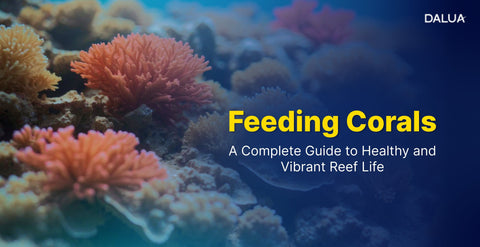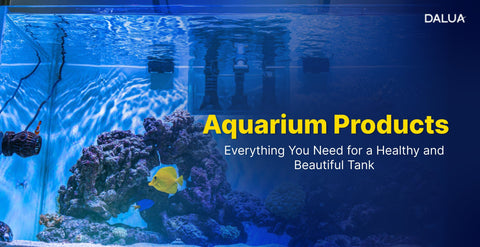How to Set Up a Reef Tank: A Complete Step-by-Step Guide
Setting up a reef tank is one of the most exciting experiences for any marine hobbyist. Watching live corals, colorful fish, and invertebrates thrive in a vibrant ecosystem is deeply rewarding. But reef aquariums are delicate systems that require planning, patience, and the right equipment.
In this guide, we’ll take you through every step from choosing the tank to adding your first coral so you can confidently create a healthy, stunning reef environment.
Step 1: Plan Your Reef Tank Setup
Before you start buying equipment, decide on the type of reef you want:
- Fish-only with live rock (FOWLR): Easier to maintain, no corals.
- Mixed reef: Combines fish, soft corals, and some hard corals.
- SPS-dominant reef: For experienced aquarists who want vibrant, fast-growing stony corals.
Planning your tank type helps determine the lighting, filtration, and dosing systems you’ll need.
Tip: Always buy slightly bigger equipment than you think you’ll need. Reef tanks perform better with overcapacity gear.
Step 2: Choose the Right Tank and Stand
Tank size influences everything — stability, equipment cost, and livestock options. A larger tank (around 200–300 litres or more) is more forgiving for beginners because it dilutes parameter changes better than smaller setups.
Key points:
- Glass tanks are durable and scratch-resistant.
- Acrylic tanks are lighter and clearer but scratch more easily.
- The stand must be sturdy, level, and capable of supporting the full weight when filled (water weighs about 4 kg per gallon).
Step 3: Gather Essential Reef Tank Equipment
Every successful reef tank runs on reliable, high-quality equipment. Here’s what you’ll need:
-
Filtration System:
A sump or canister filter helps remove waste and increase water volume. Include mechanical, biological, and chemical filtration media. -
Protein Skimmer:
Crucial for removing organic waste before it breaks down into nitrates and phosphates. -
Lighting:
Corals depend on light for photosynthesis. Choose full-spectrum LED reef lighting with adjustable intensity and color, such as the professional-grade systems available at Dalua.com. -
Heater and Thermometer:
Maintain a stable temperature of 24–26°C (75–79°F). -
Powerheads or Wave Makers:
Provide strong, variable flow to mimic ocean currents and prevent detritus buildup. -
RO/DI Water Filter:
Produces pure, contaminant-free water for mixing saltwater. -
Salt Mix and Refractometer:
Mix salt to a specific gravity of 1.025–1.026 for reef systems. -
Live Rock and Substrate:
Live rock provides biological filtration and habitat for beneficial bacteria. Use aragonite or sand substrate for a natural look. -
Test Kits and Maintenance Tools:
Regularly monitor parameters for pH, ammonia, nitrite, nitrate, calcium, alkalinity, and magnesium.
Step 4: Set Up the Tank and Equipment
- Position the tank away from direct sunlight and heavy traffic areas.
- Install the stand and ensure it’s level.
- Add substrate and rock: Place live rock securely before filling the tank to avoid collapses.
- Fill with saltwater: Mix marine salt with RO/DI water, ensuring proper salinity.
- Install equipment: Add the skimmer, heaters, powerheads, and filters.
- Check for leaks and power safety: Use drip loops and surge protectors.
Tip: Run your tank with all equipment on (but without livestock) for a full day to confirm stability before starting the cycle.
Step 5: Cycle Your Reef Tank
Cycling is the process of establishing beneficial bacteria that convert toxic ammonia into nitrite, then nitrate. This step usually takes 4–6 weeks.
How to cycle your tank:
- Add an ammonia source (like fish food or bottled ammonia).
- Use a bacterial starter to speed up the process.
- Test ammonia, nitrite, and nitrate weekly.
- Wait until ammonia and nitrite reach zero, and nitrates are low before adding any livestock.
Patience is critical here. Rushing this phase is one of the most common beginner mistakes.
Step 6: Add Cleanup Crew
Once cycling is complete, introduce a cleanup crew snails, hermit crabs, and shrimp that eat algae and leftover food. They keep your tank clean and stable before adding corals or fish.
Step 7: Introduce Corals and Fish Slowly
Start with hardy coral species like:
- Soft corals (Zoanthids, Mushrooms, Leathers)
- LPS corals (Hammer, Frogspawn, Torch)
Once they’re settled, you can gradually add more delicate species like SPS corals.
When introducing fish:
- Quarantine them first to prevent disease.
- Add one or two at a time to avoid stressing the system.
- Choose reef-safe fish that won’t nip at corals.
Step 8: Maintain Stable Parameters
A thriving reef tank depends on stability. Check water chemistry weekly and perform 10–15% water changes every two weeks.
Keep your levels balanced:
- Calcium: 400–450 ppm
- Alkalinity: 8–12 dKH
- Magnesium: 1250–1350 ppm
Use dosing pumps or all-in-one reef supplements to maintain consistency.
Step 9: Monitor and Feed Your Corals
Corals receive energy from both light and food. Feed corals phytoplankton, zooplankton, or coral-specific foods 2–3 times per week. Turn off flow during feeding to help polyps capture food.
Observe coral behavior — open polyps and strong coloration mean they’re happy. Fading colors or retracted tissue may indicate stress or poor water quality.
Step 10: Enjoy and Observe
Reef tanks mature over months, not days. Enjoy the process, keep records, and observe your system’s changes. With consistent maintenance and the right equipment from Dalua, your reef will become a living piece of the ocean in your home.
Frequently Asked Questions (FAQs)
1. How long does it take to set up a reef tank?
It typically takes 6–8 weeks to cycle and stabilize your system before adding corals and fish.
2. What’s the best size for a beginner reef tank?
A 200–300 litre tank (55–75 gallons) is ideal. It’s large enough to stay stable but still manageable.
3. Can I use tap water in my reef tank?
No. Tap water contains impurities and chlorine that can harm marine life. Always use RO/DI filtered water.
4. How often should I test water parameters?
Test weekly during setup and biweekly once the tank is established.
5. When can I add corals after cycling?
Add hardy corals 1–2 weeks after ammonia and nitrite reach zero and nitrate levels are stable.





